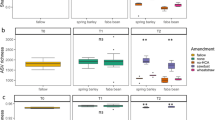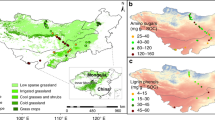Abstract
Soil microorganisms play a pivotal role in soil organic matter (SOM) turn-over and their diversity is discussed as a key to the function of soil ecosystems. However, the extent to which SOM dynamics may be linked to changes in soil microbial diversity remains largely unknown. We characterized SOM degradation along a microbial diversity gradient in a two month incubation experiment under controlled laboratory conditions. A microbial diversity gradient was created by diluting soil suspension of a silty grassland soil. Microcosms containing the same sterilized soil were re-inoculated with one of the created microbial diversities, and were amended with 13C labeled wheat in order to assess whether SOM decomposition is linked to soil microbial diversity or not. Structural composition of wheat was assessed by solid-state 13C nuclear magnetic resonance, sugar and lignin content was quantified and labeled wheat contribution was determined by 13C compound specific analyses. Results showed decreased wheat O-alkyl-C with increasing microbial diversity. Total non-cellulosic sugar-C derived from wheat was not significantly influenced by microbial diversity. Carbon from wheat sugars (arabinose-C and xylose-C), however, was highest when microbial diversity was low, indicating reduced wheat sugar decomposition at low microbial diversity. Xylose-C was significantly correlated with the Shannon diversity index of the bacterial community. Soil lignin-C decreased irrespective of microbial diversity. At low microbial diversity the oxidation state of vanillyl–lignin units was significantly reduced. We conclude that microbial diversity alters bulk chemical structure, the decomposition of plant litter sugars and influences the microbial oxidation of total vanillyl–lignins, thus changing SOM composition.






Similar content being viewed by others
References
Acosta-Matínez V, Dowd S, Sun Y, Allen V (2008) Tag-encoded pyrosequencing analysis of bacterial diversity in a single soil type as affected by management and land use. Soil Biol Biochem 40:2762–2770
Baldock JA, Oades JM, Nelson PN, Skene TM, Golchin A, Clarke P (1997) Assessing the extent of decomposition of natural organic materials using solid-state 13C-NMR spectroscopy. Aust J Soil Res 35:1061–1083
Bell T, Newman JA, Silverman BW, Turner SL, Lilley AK (2005) The contribution of species richness and composition to bacterial services. Nature 436:1157–1160
Bonkowski M, Roy J (2005) Soil microbial diversity and soil functioning affect competition among grasses in experimental microcosms. Oecologia 143:232–240
Crawford DL, Crawford RL (1980) Microbial degradation of lignin. Enzyme Microb Technol 2:11–22
Dias RF, Freeman KH, Franks SG (2002) Gas chromatography-pyrolysis-isotope ratio mass spectrometry: a new method for investigating intramolecular isotopic variation in low molecular weight organic acids. Org Geochem 33:161–186
Dignac M-F, Kögel-Knabner I, Michel K, Matzner E, Knicker H (2002) Chemistry of soil organic matter as related to C:N in Norway spruce fores (Picea abies (L.) Karst.) floors and mineral soils. J Plant Nutr Soil Sci 165:281–289
Docherty G, Jones V, Evershed RP (2001) Practical and theoretical considerations in the gas chromatography/combustion/isotope ratio mass spectrometry δ13C analysis of small polyfunctional compounds. Rapid Commun Mass Spectrom 15:730–738
Eder E, Spielvogel S, Kölbl A, Albert G, Kögel-Knabner I (2010) Analysis of hydrolysable neutral sugars in mineral soils: improvement of alditol acetylation for gas chromatographic separation and measurement. Org Geochem 41:580–585
Frey SD, Knorr M, Parrent JL, Simpson RT (2004) Chronic nitrogen enrichment affects the structure and function of the soil microbial community in temperate hardwood and pine forests. For Ecol Manage 196:159–171
Griffiths BS, Ritz K, Bardgett RD, Cook R, Christensen S, Ekelund F, Søensen SJ, Bååth E, Bloem J, de Ruiter PC, Dolfing JK, Nicolardot B (2000) Ecosystem response of pasture soil communities to fumigation-induced microbial diversity reductions: an examination of the biodiversity-ecosystem function relationship. Oikos 90:279–294
Griffiths BS, Ritz K, Wheatley R, Kuan HL, Boag B, Christensen S, Ekelund F, Sørensen SJ, Muller S, Bloem J (2001) An examination of the biodiversity–ecosystem function relationship in arable soil microbial communities. Soil Biol Biochem 33:1713–1722
Griffiths BS, Kuan HL, Ritz K, Glover LA, McCaig AE, Fenwick C (2004) The relationship between microbial community structure and functional stability, tested experimentally in an upland pasture soil. Microb Ecol 47:104–113
Guggenberger G, Zech W (1994) Land-use effects on the composition of organic matter in particle-size separates of soil: I. Lignin and carbohydrate signature. Eur J Soil Sci 45:449–458
Guggenberger G, Zech W, Thomas RJ (1995) Lignin and carbohydrate alteration in particle-size separates of an oxisol under tropical pastures following native Savanna. Soil Biol Biochem 27:1629–1638
Hedges JI, Ertel JR (1982) Characterization of lignin by gas capillary chromatography of cupric oxide oxidation products. Anal Chem 54:174–178
Kirk TK, Schultz E, Connors WJ, Lorenz LF, Zeikus JG (1978) Influence of culture parameters on lignin metabolism by Phanerochaete chrysosporium. Arch Microbiol 117:277–285
Kögel I, Bochter R (1985) Characterization of lignin in forest humus layers by high-performance liquid chromatography of cupric oxide oxidation products. Soil Biol Biochem 17:637–640
Kögel-Knabner I (2002) The macromolecular organic composition of plant and microbial residues as inputs to soil organic matter. Soil Biol Biochem 34:139–162
López-Gutiérrez JC, Henry S, Hallet S, Martin-Laurent F, Catroux G, Philippot L (2004) Quantification of a novel group of nitrate-reducing bacteria in the environment by real-time PCR. J Microbiol Methods 57:399–407
Manlay RJ, Feller C, Swift MJ (2007) Historical evolution of soil organic matter concepts and their relationships with the fertility and sustainability of cropping systems. Agric Ecosyst Environ 119:217–233
Meyer MC, Paschke MW, McLendon T, Price D (1998) Decreases in soil microbial function and functional diversity in response to depleted uranium. J Environ Qual 27:1306–1311
Nacke H, Thürmer A, Wollherr A, Will C, Hodac L, Herold N, Schöning I, Schrumpf M, Daniel R (2011) Pyrosequencing-based assessment of bacterial community structure along different management types in German forest and grassland soils. PLoS One 6:e17000
Niemenmaa O, Uusi-Rauva A, Hatakka A (2008) Demethoxylation of [O14CH3]-labelled lignin model compounds by the brown-rot fungi Gloeophyllum trabeum and Poria (Postia) placenta. Biodegradation 19:555–565
Oades JM (1984) Soil organic matter and structural stability: mechanisms and implications for management. Plant Soil 76:319–337
Perelo LW, Munch JC (2005) Microbial immobilisation and turnover of 13C labelled substrates in two arable soils under field and laboratory conditions. Soil Biol Biochem 37:2263–2272
Rieley G (1994) Derivatization of organic compounds prior to gas chromatographic-combustion-isotope ratio mass spectrometric analysis: identification of isotope fractionation processes. Analyst 119:915–919
Romani AM, Fischer H, Mille-Lindblom C, Tranivik LJ (2006) Interactions of bacteria and fungi on decomposing litter: differential extracellular enzyme activities. Ecology 87:2559–2569
Ruess L, Michelsen A, Schmidt IK, Jonasson S (1999) Simulated climate change affecting microorganisms, nematode density and biodiversity in subarctic soils. Plant Soil 212:63–73
Rumpel C, Dignac M-F (2006) Gas chromatographic analysis of non-cellulosic neutral polysaccharides in a forest soil profile: analysis by gas chromatography after trifluoroacetic acid hydrolysis and reduction–acetylation. Soil Biol Biochem 38:1478–1481
Salles JF, Poly F, Schmid B, Le Roux X (2009) Community niche predicts the functioning of denitrifying bacterial assemblages. Ecology 90:3324–3332
Salonius PO (1981) Metabolic capabilities of forest soil microbial populations with reduced species diversity. Soil Biol Biochem 13:1–10
Setälä H, McLean MA (2004) Decomposition rate of organic substrates in relation to the species diversity of soil saprophytic fungi. Oecologia 139:98–107
Slater JH, Lovatt D (1984) Biodegradation and the significance of microbial communities. In: Gibson DT (ed) Microbial degradation of organic compounds. Marcel Dekker, Inc., New York, pp 439–485
Smit E, Leeflang P, Gommans S, van den Broek J, van Mil S, Wernars K (2001) Diversity and seasonal fluctuations of the dominant members of the bacterial soil community in a wheat field as determined by cultivation and molecular methods. Appl Environ Microbiol 67:2284–2291
Spielvogel S, Prietzel J, Kögel-Knabner I (2007) Changes of lignin phenols and neutral sugars in different soil types of a high-elevation forest ecosystem 25 years after forest dieback. Soil Biol Biochem 39:655–668
R Development Core Team (2008) R: A language and environment for statistical computing. R Foundation for Statistical Computing, Vienna. ISBN 3-900051-07-0. http://www.R-project.org
Terrat S, Christen R, Dequiedt S, Lelievre M, Nowak V, Regnier T, Bachar D, Plassart P, Wincker P, Jolivet C, Bispo A, Lemanceau P, Maron P-A, Mougel C, Ranjard L (2012) Molecular biomass and MetaTaxogenomic assessment of soil microbial communities as influenced by soil DNA extraction procedure. Microb Biotechnol 5:135–141
Thevenot M, Dignac M-F, Rumpel C (2010) Fate of lignins in soils: a review. Soil Biol Biochem 42:1200–1211
Torsvik V, Øvreås L (2002) Microbial diversity and function in soil: from genes to ecosystems. Curr Opin Microbiol 5:240–245
Vainio EJ, Hantula J (2000) Direct analysis of wood-inhabiting fungi using denaturing gradient gel electrophoresis of amplified ribosomal DNA. Mycol Res 104:927–936
van Elsas JD, Chiurazzi M, Mallon CA, Elhottovā D, Krištůfek V, Salles JF (2011) Microbial diversity determines the invasion of soil by a bacterial pathogen. PNAS 109:1159–1164
van Veen JA, Kuikman PJ (1990) Soil structural aspects of decomposition of organic matter by micro-organisms. Biogeochemistry 11:213–233
Wertz S, Degrange V, Prosser JI, Poly F, Commeaux C, Freitag T, Guillaumaud N, Le Roux X (2006) Maintenance of soil functioning following erosion of microbial diversity. Environ Microbiol 8:2162–2169
Acknowledgments
This project was financed by the Agence Nationale de Recherche (ANR) under the framework of the Systerra project DIMIMOS.
Author information
Authors and Affiliations
Corresponding author
Rights and permissions
About this article
Cite this article
Baumann, K., Dignac, MF., Rumpel, C. et al. Soil microbial diversity affects soil organic matter decomposition in a silty grassland soil. Biogeochemistry 114, 201–212 (2013). https://doi.org/10.1007/s10533-012-9800-6
Received:
Accepted:
Published:
Issue Date:
DOI: https://doi.org/10.1007/s10533-012-9800-6




